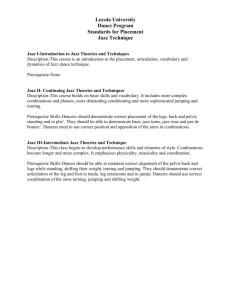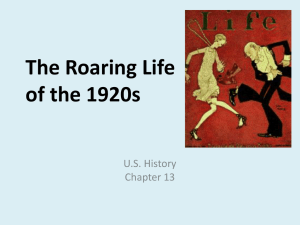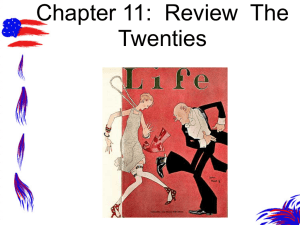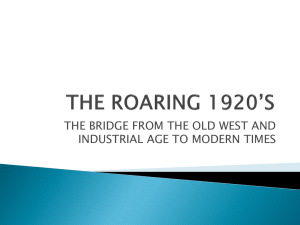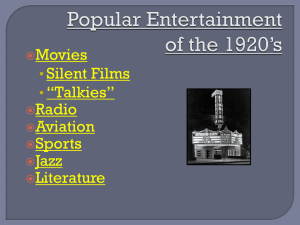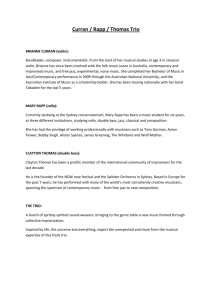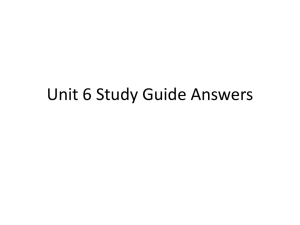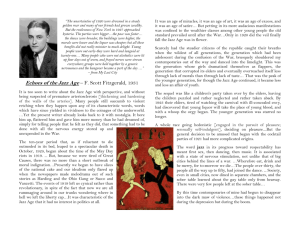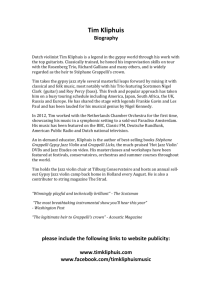1920`s notes and quick answers
advertisement
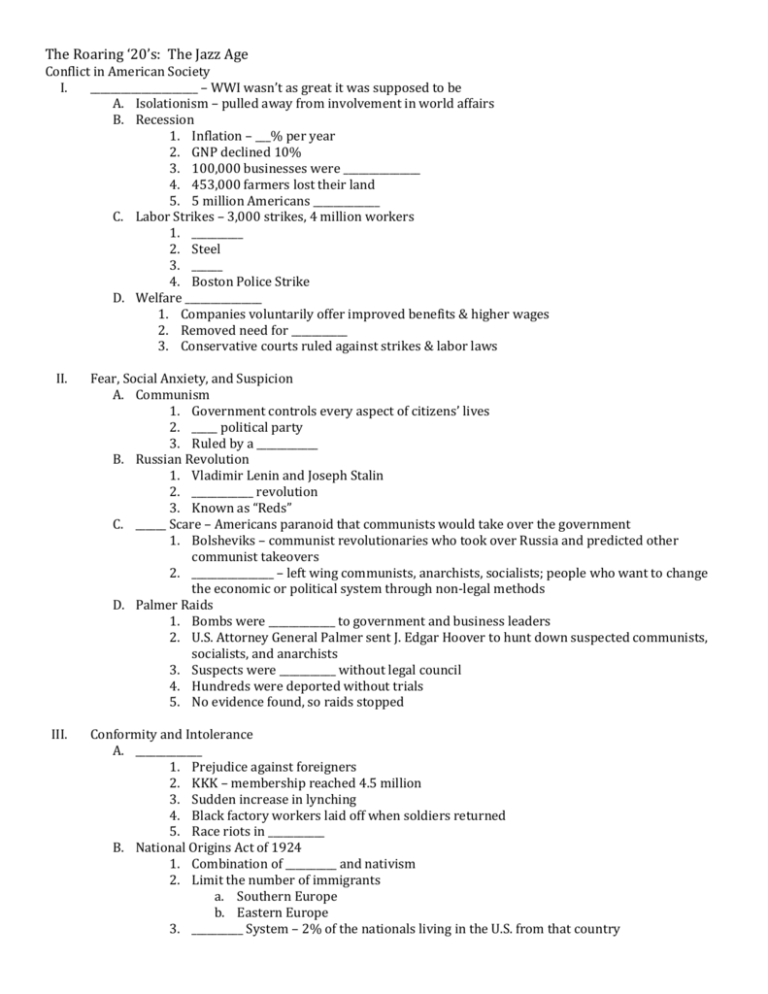
The Roaring ‘20’s: The Jazz Age Conflict in American Society I. _____________________ – WWI wasn’t as great it was supposed to be A. Isolationism – pulled away from involvement in world affairs B. Recession 1. Inflation – ___% per year 2. GNP declined 10% 3. 100,000 businesses were _______________ 4. 453,000 farmers lost their land 5. 5 million Americans _____________ C. Labor Strikes – 3,000 strikes, 4 million workers 1. __________ 2. Steel 3. ______ 4. Boston Police Strike D. Welfare _______________ 1. Companies voluntarily offer improved benefits & higher wages 2. Removed need for ___________ 3. Conservative courts ruled against strikes & labor laws II. III. Fear, Social Anxiety, and Suspicion A. Communism 1. Government controls every aspect of citizens’ lives 2. _____ political party 3. Ruled by a ____________ B. Russian Revolution 1. Vladimir Lenin and Joseph Stalin 2. ____________ revolution 3. Known as “Reds” C. ______ Scare – Americans paranoid that communists would take over the government 1. Bolsheviks – communist revolutionaries who took over Russia and predicted other communist takeovers 2. ________________ – left wing communists, anarchists, socialists; people who want to change the economic or political system through non-legal methods D. Palmer Raids 1. Bombs were _____________ to government and business leaders 2. U.S. Attorney General Palmer sent J. Edgar Hoover to hunt down suspected communists, socialists, and anarchists 3. Suspects were ___________ without legal council 4. Hundreds were deported without trials 5. No evidence found, so raids stopped Conformity and Intolerance A. _____________ 1. Prejudice against foreigners 2. KKK – membership reached 4.5 million 3. Sudden increase in lynching 4. Black factory workers laid off when soldiers returned 5. Race riots in ___________ B. National Origins Act of 1924 1. Combination of __________ and nativism 2. Limit the number of immigrants a. Southern Europe b. Eastern Europe 3. __________ System – 2% of the nationals living in the U.S. from that country The Roaring ‘20’s: The Jazz Age a. Ex. – 100,000 Italians: 2,000 would be allowed into U.S. b. Ended all immigration from Japan 4. Sacco & Vanzetti a. Factory paymaster and guard were robbed and murdered b. Found __________ and sentenced to ____________ C. Native American Citizenship Act of 1924 1. Granted full _____________ 2. Did not have to give up tribal citizenship 3. All Native Americans weren’t allowed to _________ until 1948 IV. V. Alienation A. Rural Values vs. Urban Values 1. __________ = country side or farms 2. Rural values = more ____________ B. 18th Amendment – Prohibition 1. banned the sale, manufacture, and transportation of ____________ 2. people in the country saw alcohol as an evil of __________ life C. Speakeasy 1. People kept drinking in underground _________ 2. Speak softly so cops couldn’t hear you and bust it up D. Bootlegging 1. ________________ was allowed for medicinal or religious purposes 2. Smuggled it from Canada, Cuba, or West Indies 3. ________________ – People who made it themselves (sometimes hid it in their boot) E. Growth of Organized ___________ 1. Al Capone – bootlegger of ____________ 2. Valentine’s Day Massacre – his gang killed a rival gang F. Science vs. Religion 1. Fundamentalism – literal interpretation of the ____________ 2. Rejected the theory of ________________ a. Evolution – plants and animals change over time b. Humans evolved from ___________ 3. Scientific theory – is proven over and over G. Scopes “Monkey” Trial 1. ______________ outlawed the teaching of Darwin’s Theory of Evolution in public schools 2. John T. Scopes – science teacher who taught it anyway, was ____________ and put on trial 3. William Jennings Bryan – prosecutor (fundamentalist) 4. Clarence Darrow – defense attorney a. Put Bryan on the stand and questioned him about the __________ b. Bryan admitted that he didn’t believe in literal translation of creation 5. Scopes found _____________, but states began allowing the teaching of evolution Causes of Business Prosperity A. Post-War Demand from _____________ Markets 1. European countries were in ____________ 2. U.S. supplied goods to help rebuild industry B. Government Policies 1. ___________ tariffs to protect American businesses 2. Low __________ to encourage investment C. New Technologies and Innovations 1. Taylorism and assembly line – increase efficiency/mass production 2. ____________ industry – “talkie” movies increased attendance D. Commercial ________________ 1. Developed slowly – delivering mail The Roaring ‘20’s: The Jazz Age 2. Pressurized cabins 3. Glenn Curtiss – founder of U.S. aircraft industry E. Consumerism 1. _________________ 2. Installment plan VI. VII. VIII. The Harding Presidency: “Return to Normalcy” – return to Progressive Era policies A. Fordney-McCumber Tariff 1. Raised taxes on imports to 60% 2. Americans stopped buying foreign products B. Scandals 1. Harding’s cabinet were made up of his poker buddies known as the Ohio Gang 2. Used their political positions to become wealthy (graft) 3. Teapot Dome Scandal a. Teapot Dome – piece of land in Wyoming owned by the government b. Sec of Interior Albert Fall leased the land to an oil company and kept $400,000 c. Found guilty of bribery President Calvin Coolidge A. Business of America 1. Believed in laissez-faire economics 2. Gave businesses more credit to expand B. Urban Sprawl 1. Cities began to spread 2. Automobiles allowed workers to commute from farther away C. Installment Plans 1. Household appliances and automobiles 2. Small monthly payments 3. Americans bought items they couldn’t afford Changing ways of life A. Women – asserted their independence 1. Flapper – emancipated young woman who embraced new fashions and urban attitudes a. Felt hats, short dresses; short, dyed hair b. Smoked cigarettes, drank in public, talked openly about sex 2. Double Standard a. Women had stricter standards of behavior b. 1920’s women rejected those standards 3. Charles Lindbergh a. 1st non-stop solo flight across the Atlantic Ocean b. N.Y. City to Paris in 33 hours & 29 minutes 4. Harlem Renaissance a. Many blacks moved to Harlem, a borough of NYC, and became the world’s largest Black urban community b. Literature, the arts, and entertainment i. Langston Hughes – writer ii. Louis Armstrong – Jazz musician iii. Duke Ellington – Jazz composer Quick Answer Questions 1. Imagine you are running for President in 1920. Which issue would you use to convince the American people to vote for you? A) Isolationism B) Recession/Economy The Roaring ‘20’s: The Jazz Age C) Labor Conflict/Strikes 2. List the items in the cartoon. What do they mean? What is the main idea of the cartoon? Analyze this cartoon. 3. Match the Causes and effects Nativism Palmer Raids Red Scare Sacco & Vanzetti National Origins Act Race Riots Analyze this cartoon. 4. Who is responsible for the Teapot Dome Scandal? How do you know? 5. Which political party was hurt by the scandal? How do you know? The Roaring ‘20’s: The Jazz Age 6. What other big products do you think that people would buy on an installment plan besides an automobile? Name at least two. 7. Why are the 1920’s also known as the Jazz Age? 8. Name one woman today who you would consider a modern day flapper.

